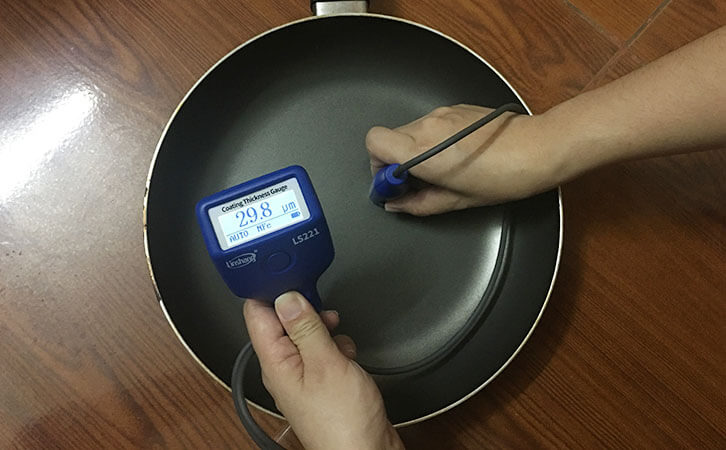Non-stick Pan Coating and Dry Mil Paint Thickness Gauge
In the family, people often worry about sticky pans when cooking or frying eggs, so they choose to buy non-stick pans. So what is the mystery of the non-stick non-stick pan? The answer lies in the coating of the nonstick pan.
The non-stick coating is a non-stick coating composite. First, there are the most traditional and most popular Teflon coatings, as well as emerging ceramic coatings, maifan stone coatings, diamond coatings, etc. The types of non-stick pans currently on the market can be divided into polytetrafluoroethylene (Teflon) coating, ceramic coating and silicone coating. The material of the coating has good lubricity and a small friction coefficient. These excellent physical properties make it difficult for the substance to adhere to it. The coating material has a decisive influence on the performance of non-stick pans. The material of the non-stick coating will affect the continuous use of the coating and the precipitated materials. The thickness of non-stick coatings will affect total migration, potassium permanganate consumption, heavy metals, etc. The total migration will affect the migration and precipitation of water, acidity, oiliness and other substances in contact with the surface of the non-stick coating. Excessive precipitation will cause certain harm to human health.
Therefore, the thickness of the non-stick coating is very important. Only when the coating thickness reaches a certain standard, can we ensure the quality of the non-stick pan. The national food safety standards for food contact materials and coatings set out that the coating thickness of non-stick pans must meet relevant standards to ensure that the total migration of household pans, potassium permanganate consumption, heavy metals should meet the requirement. In addition, it is also stated in the relevant requirements of the National Light Industry Industry Standard on aluminum and aluminum alloy non-stick pans that the average thickness of non-stick pan coatings for wok pans should be greater than or equal to 25μm. Only when the coating thickness meets certain requirements can the pot be more resistant to acid, alkali, salt water, etc., It is not prone to peeling, blistering, cracking, shrinkage and other phenomena. For the coating thickness measurement of non-stick pans, a professional instrument- dry mil paint thickness gauge should be selected for thickness analysis to ensure that the coating thickness of household pots reaches the basic specifications. Then the coating thickness performance is further improved to better achieve "non-stick "effect.
Using a dry mil paint thickness gauge to measure the coating thickness of non-stick pans can prevent unqualified products from being exposed to the market during the production process. The coating of non-stick coating should be applied thinly and repeatedly, so that the coating film can be dense. Through the analysis of the dry mil paint thickness gauge, the density and viscosity of non-stick pans can also be known. Coating anticorrosion is to separate the surface layer from the medium with a cover layer to protect the surface layer. With a guaranteed coating thickness, the corrosion resistance will also be better.
According to the coating of non-stick pan, please choose non-stick pan. For example, some pots use Eclipse coating, etc. This coating has 3 structures, the bottom layer is resin and the surface layer contains PTFE and mineral powder. The coating is easy to peel off, but the non-stick performance is better. In the purchase of non-stick pans, you should also use a dry mil paint thickness gauge to measure the coating thickness.
- High precision coating thickness gauge for used car
- Automotive paint protection films coating thickness gauge
- Plating Thickness Measuring Instrument for Detecting Anti-corrosion Coating
- Linshang LS220, LS191, LS160A– Necessary for Car Cover Inspection
- Coating Thickness Gauge for Second Hand Vehicle
- Zero Adjustment Step of Coating Thickness Gauge
